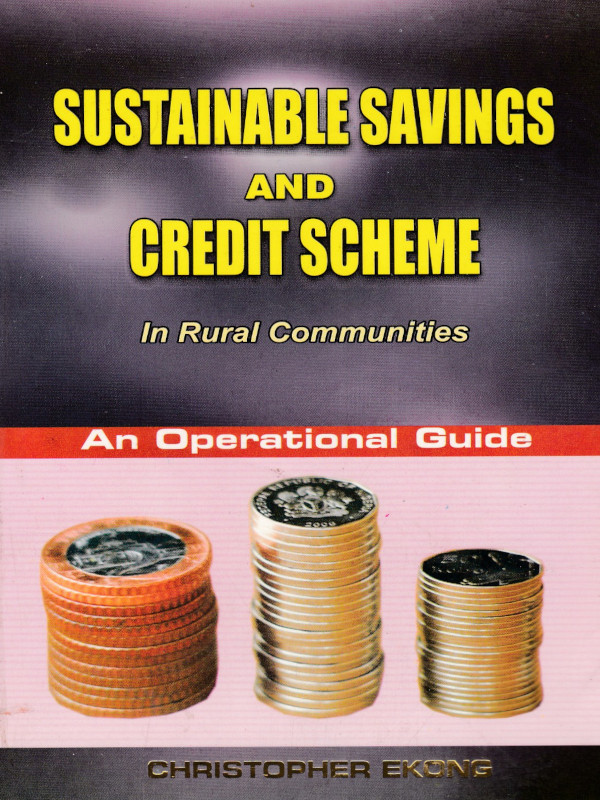Sustainable Savings and Credit Scheme in Rural Communities: An Operational Guide
$15.00
Foreword
It is a well-known fact that since independence, Nigeria’s development efforts have shown obvious targeting of the banking sector in order to generate funds for growth and development. Various administrations have vigorously implemented various programmes aimed at providing credit for rural development but have achieved minimal results. The results have been obviously dismal.
Researches targeted at finding solutions to the problem of rural development funding gave birth to some schemes such as Rural Banking Scheme, Community Banks, Peoples Bank, among others. Yet almost ail were met with failures. Further efforts to find solutions culminated in sets of researches to identify an appropriate rural development funding strategy. One of such research projects, motivated by the dismal failure of previous rural credit generation initiatives, led the author to focus on the Community Savings and Credit Scheme (CS&CS). This is a rural credit methodology that has been tested with considerable success rate. The experiments, conducted in Mbiabet Ikpe, Akwa Ibom State and Egbemo-Angalabiri in Bayelsa State, have recorded tremendous success rates.
The CS&CS is a community initiative that seeks to pool funds together for the purpose of promoting savings culture and encouraging local investments for the creation of wealth. It is mainly on development approach, which entails the evolution or development of a process where individual community members are encouraged to develop a sense of thrift, saving their even little or limited funds for onward disbursement to themselves as credit. When fully established, the CS&CS could run like a local bank with obviously very simple operational mechanisms and guidelines. The author was deeply involved in the setting up of the CS&CS in the two communities of Mbiabet Ikpe and Egbemo-Angalabiri, both in Nigeria’s Niger Delta.
In 1994, he was the consultant of African Development Bank (ADB)-funded project in Mbiabet Ikpe. While there, he discovered that the most serious, critical and immediate problem was “credit unavailability”. But with constant and participatory dialogue with the community he was able to initiate the establishment of the Community Savings and Credit Scheme in the community. Also, while in Egbemo-Angalabiri on an NDES (Niger Delta Environmental Survey)-funded project, the author got involved in the take-off of the CS&CS there. To ensure its effective establishment, he organized an exchange visit by the Egbemo- Angalabiri people to Mbiabet Ikpe. The four-day visit elevated interest and concern for the CS&CS. At the end, the scheme was successfully replicated.
The success recorded in both communities is a pointer to the fact that rural communities, though often neglected hold enormous financial and investment power. It shows that if properly harnessed micro-credit schemes in “poor”, rural areas can serve as catalysts to the rapid economic and social development of any nation. This is even true in the so-called third-world countries. This book, therefore, is a recommendation to government and development agencies that are involved in policies and programmes geared towards the sustainable development of the masses. Is a very practical guide on how to bring the best out of the often neglected rural people.
However, the ideas that will evolve from this book should not be seen as a total blueprint, to be followed without flexibility, rather to be seen as a process that may need several and even serious adaptations to meet the needs and requirements of specific environments.
It is a book that so much energy, time and funds have been put into. It is a book that evolves a practical guide to a Sustainable Savings and Credit Scheme in Rural Communities.
Christopher Nyong Ekong (Ph.D)
Description
Contents
Chapter 1
Conceptual Background
Chapter 2
Towards Raising Rural Credit in Nigeria
Agricultural Credit Guarantee Scheme Fund
The Rural Banking Scheme
DFRRI
Community Banking
Better Life for Rural Women
Family Economic Advancement Scheme, FEAP
Peoples Bank
Chapter 3
Formation Process for CS & CS
Formation of Interest Group
Chapter 4
Setting a Sustainable Interest Rate – –
The Carmen Creditica Microfin Method –
Chapter 5
Community Savings and Credit Scheme (CS & CS)
Credit Sources
Monitoring Loan
Advantages of the CS & CS
Condition for Sustenance of the CS & CS
Chapter 6
The CS & CS Model Experiment in Mbiabet Ikpe Community
Chapter 7
The Egbemo Angalabiri Experience
Logical Framework
Financial Profile Before Experience
Process to Egbemo-Angalabiri CS & CS Formation
Target Group of E-A CS & CS
Chapter 8
Benefits of Mbiabet Ikpe CS & CS to the Community
Establishment of a Secondary School – –
Reorganization of Rice Farm – – –
Improved Savings Habits of the Locals –
Improved Transparency and Democratic Norms
Chapter 9
Creating Awareness for the Replication of the CS & CS Scheme in the Niger Delta
The Announcement
The Familiarization / Reality Visit
Events in the Familiarization Visits
Chapter 10
Challenges and Recommendations for the CS & CS
Community Evaluation
Bibliography
Postscript: Christopher Ekong
Appendices
Prof. Christopher Ekong
Christopher Ekong is a professor of Economics at Faculty of Social Science, University of Uyo. His indepth research in Monetary Economics, Money & Banking, Environmental Economics, Economic Development and more has given birth to highly sought after Books, Book Chapters and Journal Articles. Majority are open access in his personal knowledgebase which is accessible at www.christopherekong.com.ng.
Questions and Answers
You are not logged in
